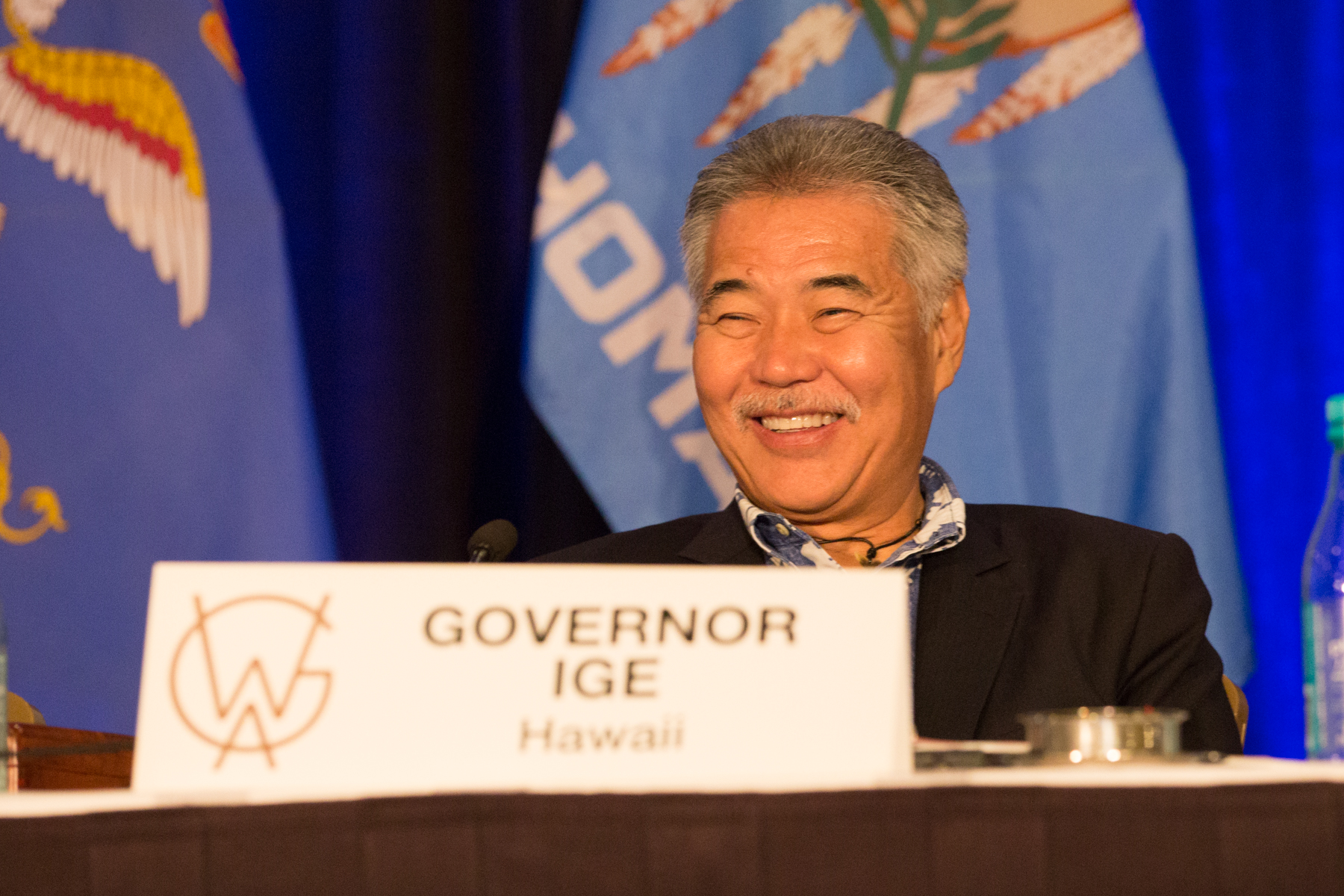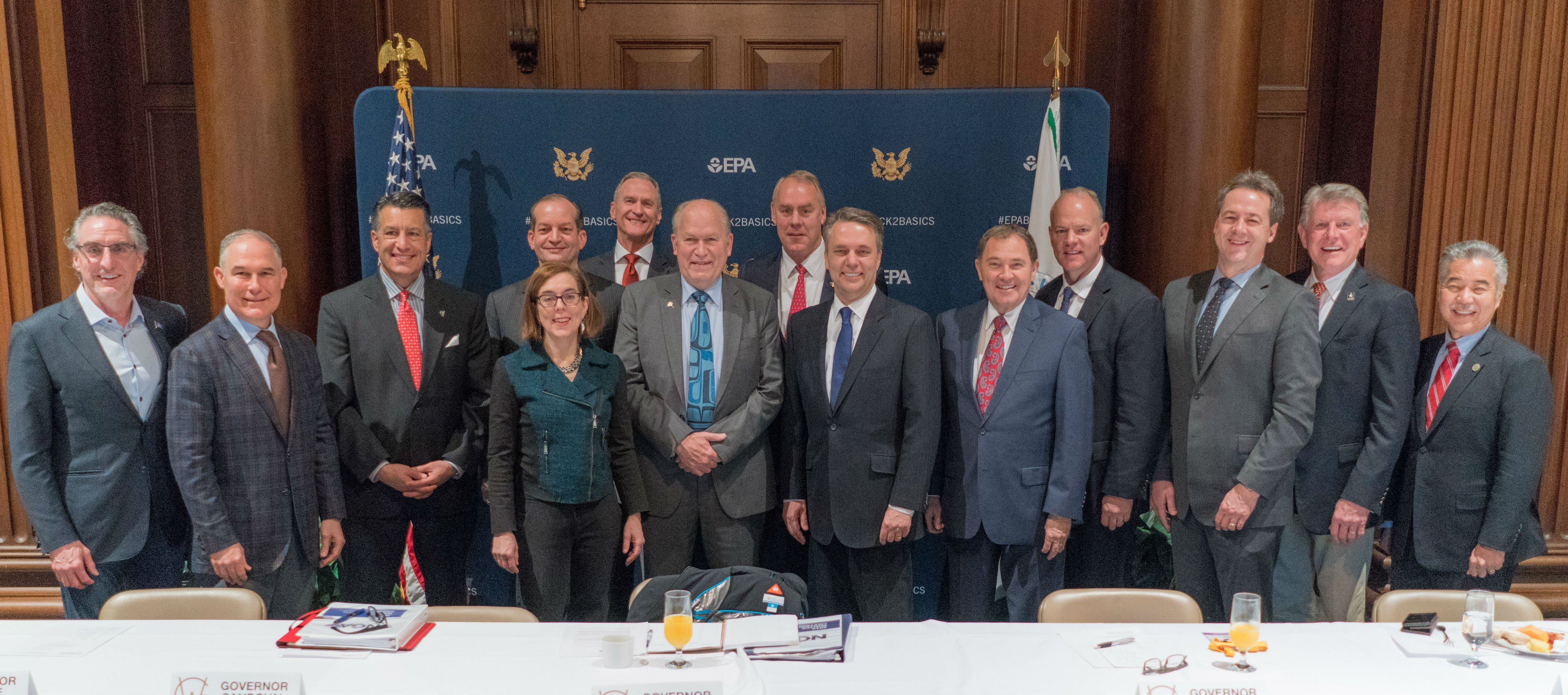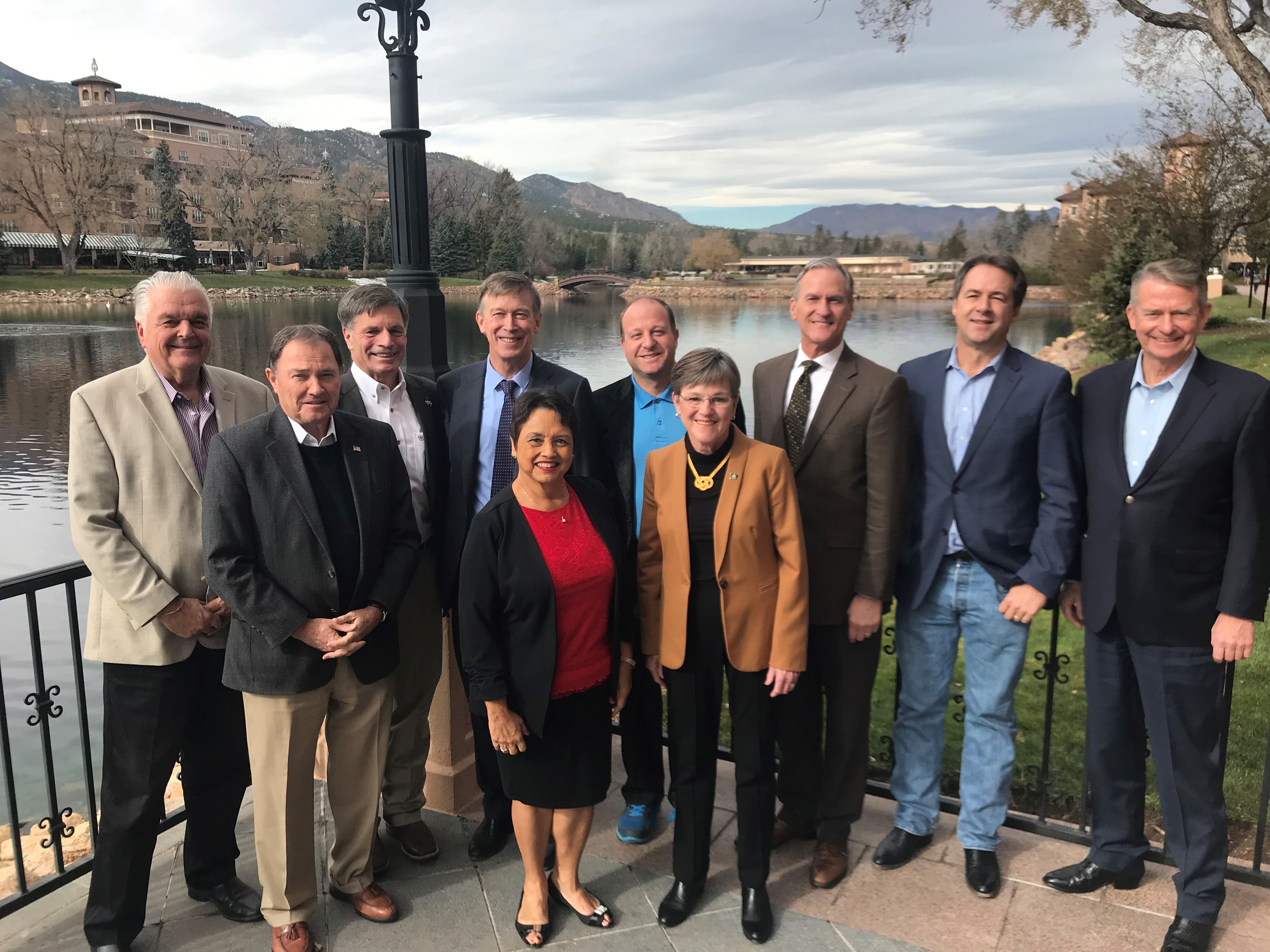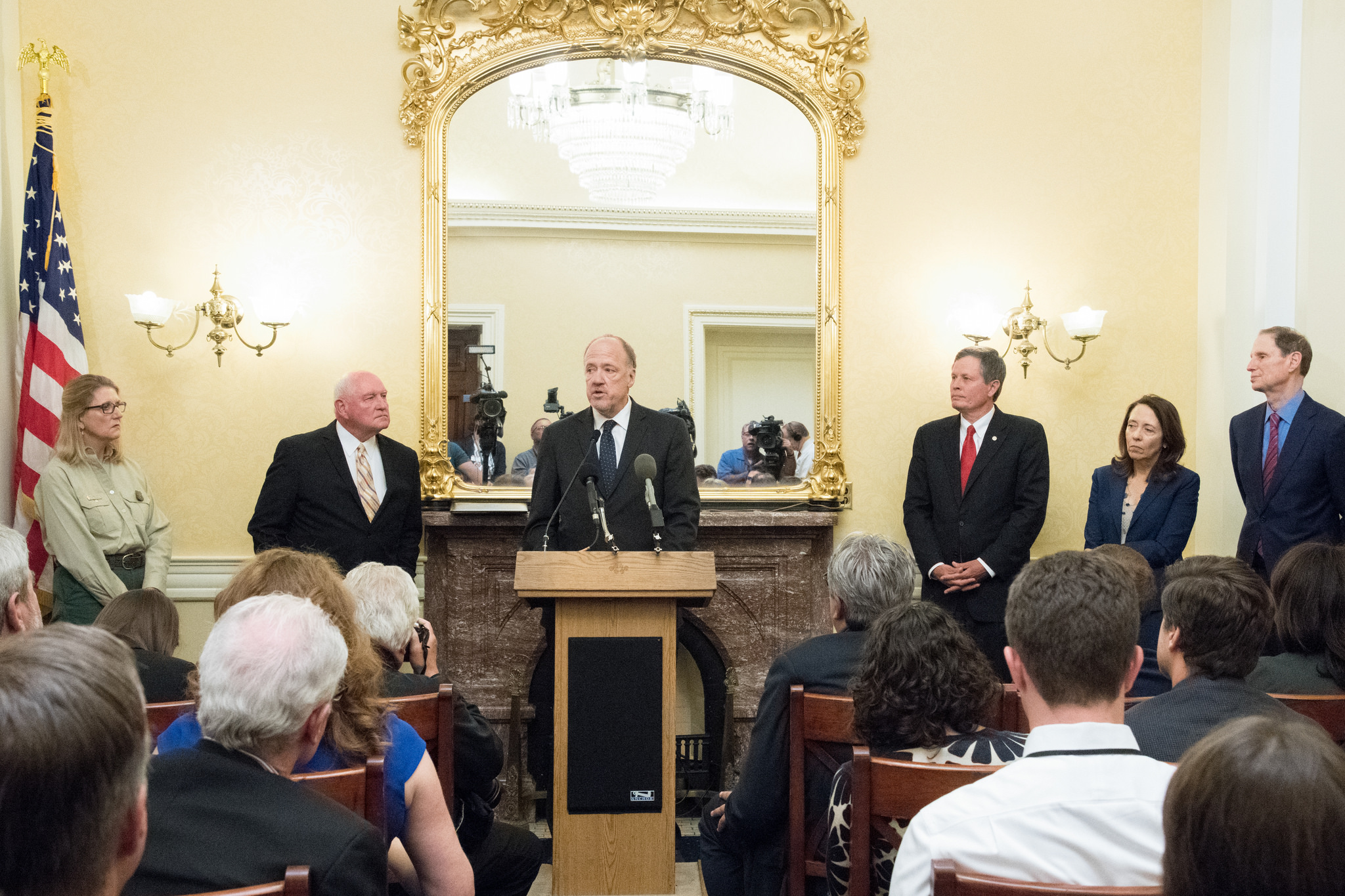As Western Governors have become increasingly active and effective, it has become correspondingly more difficult to condense their annual accomplishments into a Top Ten list. It would be easier to identify their top 50 or 100 achievements; winnowing the list to ten is much more challenging. Be that as it may, I am pleased to present the 2018 Top Ten list of Western Governors’ accomplishments, projects and activities.
1. Groundbreaking Initiatives
 The Western Governors’ Workforce Development Initiative, an ambitious project designed by WGA’s immediate past Chair, Governor Dennis Daugaard of South Dakota, developed strategies to bridge the skills gap separating worker competencies from employer requirements in the West. The Initiative – which also focused on the creation of enhanced opportunities for students, graduates and displaced workers – was the predicate for WGA Policy Resolution, Workforce Development in the Western United States, adopted by Governors in connection with the 2018 WGA Annual Meeting in South Dakota. The Workforce Development Initiative Year-One Report, published in June, presents findings and recommendations anchored to six themes: integration of state efforts; valuation of all pathways; connection of education to careers; creation of pathways to in-demand careers; the need to upgrade skills; and the imperative to address rural challenges.
The Western Governors’ Workforce Development Initiative, an ambitious project designed by WGA’s immediate past Chair, Governor Dennis Daugaard of South Dakota, developed strategies to bridge the skills gap separating worker competencies from employer requirements in the West. The Initiative – which also focused on the creation of enhanced opportunities for students, graduates and displaced workers – was the predicate for WGA Policy Resolution, Workforce Development in the Western United States, adopted by Governors in connection with the 2018 WGA Annual Meeting in South Dakota. The Workforce Development Initiative Year-One Report, published in June, presents findings and recommendations anchored to six themes: integration of state efforts; valuation of all pathways; connection of education to careers; creation of pathways to in-demand careers; the need to upgrade skills; and the imperative to address rural challenges.
 The Western Governors’ Biosecurity and Invasive Species Initiative was launched in July by WGA’s Chair, Hawaii Governor David Ige. The initiative focuses on the impacts that nuisance species, pests and pathogens have on ecosystems, forests, rangelands, watersheds and infrastructure in the West. It is also examining the role that biosecurity plays in addressing the risks posed by invasive species. Initiative workshops were hosted by: Nevada Governor Brian Sandoval at Lake Tahoe in September; Wyoming Governor Matt Mead in Cheyenne in October; Montana Governor Steve Bullock in Helena in November; and Hawaii Governor David Ige on the Kohala Coast of the Big Island in December. Work of the Initiative will continue in 2019 with a series of webinars focused on: the impacts of invasive species on fisheries; biosecurity and national defense; invasive species management and railways; implementation of the Vessel Incidental Discharge Act; and state authority in quarantine decisions. An Initiative report will be presented to Western Governors at their 2019 Annual Meeting in Vail, Colorado.
The Western Governors’ Biosecurity and Invasive Species Initiative was launched in July by WGA’s Chair, Hawaii Governor David Ige. The initiative focuses on the impacts that nuisance species, pests and pathogens have on ecosystems, forests, rangelands, watersheds and infrastructure in the West. It is also examining the role that biosecurity plays in addressing the risks posed by invasive species. Initiative workshops were hosted by: Nevada Governor Brian Sandoval at Lake Tahoe in September; Wyoming Governor Matt Mead in Cheyenne in October; Montana Governor Steve Bullock in Helena in November; and Hawaii Governor David Ige on the Kohala Coast of the Big Island in December. Work of the Initiative will continue in 2019 with a series of webinars focused on: the impacts of invasive species on fisheries; biosecurity and national defense; invasive species management and railways; implementation of the Vessel Incidental Discharge Act; and state authority in quarantine decisions. An Initiative report will be presented to Western Governors at their 2019 Annual Meeting in Vail, Colorado.
2. Impactful Resolutions
During the course of the year, Western Governors adopted 16 substantive and detailed policy resolutions to guide WGA work in a growing number of issue areas. Resolutions are effective for three years from the date of their adoption. At the 2018 Winter Meeting in Hawaii, the Governors announced the adoption of resolutions regarding: preclearance of foreign visitors, cybersecurity, compensatory mitigation, and health care.

3. Fierce Defense of State Authority
Organizing and leading a national coalition of state and local water associations, WGA launched a vigorous and successful defense of state authority to issue water quality certifications under Section 401 of the Clean Water Act. Spearheading this effort and executing a multi-faceted strategy, WGA worked with its national partners to preserve this important state authority, which remains under sharp attack by interests promoting certain interstate infrastructure projects.
In late February, at the urging of Western Governors, the Department of the Interior revised its draft reorganization maps to better align departmental regions with state boundaries. WGA continues to work with the Department to improve its reorganization plan.
Consistent with the Governors’ policy position, EPA decided against issuing final regulations imposing duplicative financial assurance requirements on hardrock mining activities. Similarly, the Bureau of Land Management proposed to revisit its 2016 rule on methane regulation, acknowledging the position of Western Governors that states have the requisite competency and authority to responsibly regulate methane emissions.
4. Strengthening the State-Federal Relationship
Western Governors have almost single-handedly energized what has become a national conversation with Congress and federal agencies on the need for a more coherent and balanced state-federal relationship. To promote this conversation, WGA created and manages the Western Policy Network, a confederation of state and local associations invested in the reinvention of the state-federal paradigm.
In late February, three Western Governors testified at a joint hearing of the House Committee on Oversight and Government Reform and the Speaker’s Task Force on Intergovernmental Affairs. The subject of the hearing was “Federalism Implications of Treating States as Stakeholders.” Utah Governor Gary Herbert, Idaho Governor C.L. “Butch” Otter and New Mexico Governor Susana Martinez educated the panels as to principles embedded in WGA Policy Resolution 2017-01, Building a Stronger State-Federal Relationship.
 Concurrent with the hearing described above, WGA (in cooperation with partner associations) hosted a State and Local Government Associations Summit at the Pew Center in Washington, D.C. The gathering was designed to explore potential improvements to the state-federal relationship with representatives of the Administration. The Executive Office of the President was represented by officials from the White House, Council on Environmental Quality, Office of Management and Budget and the Office of Information and Regulatory Affairs. Participating agencies included Environmental Protection Agency and the Departments of the Interior, Education, Labor, Agriculture and Homeland Security. Governor Herbert and Representative Rob Bishop, Chairman of the House Committee on Natural Resources, joined the summit for a roundtable discussion on federalism.
Concurrent with the hearing described above, WGA (in cooperation with partner associations) hosted a State and Local Government Associations Summit at the Pew Center in Washington, D.C. The gathering was designed to explore potential improvements to the state-federal relationship with representatives of the Administration. The Executive Office of the President was represented by officials from the White House, Council on Environmental Quality, Office of Management and Budget and the Office of Information and Regulatory Affairs. Participating agencies included Environmental Protection Agency and the Departments of the Interior, Education, Labor, Agriculture and Homeland Security. Governor Herbert and Representative Rob Bishop, Chairman of the House Committee on Natural Resources, joined the summit for a roundtable discussion on federalism.
During a WGA breakfast meeting with U.S. cabinet secretaries in February, 13 Western Governors discussed critical policy issues facing the West with three top Administration officials: Secretary of the Interior Ryan Zinke, Secretary of Labor Alex Acosta and Environmental Protection Agency Administrator Scott Pruitt. Participants in this roundtable at EPA headquarters in Washington D.C. included: WGA Chair and South Dakota Governor Dennis Daugaard, WGA Vice Chair and Hawaii Governor David Ige, Montana Governor Steve Bullock, Wyoming Governor Matthew Mead, Colorado Governor John Hickenlooper, Nevada Governor Brian Sandoval, Utah Governor Gary Herbert, Idaho Governor C.L. “Butch” Otter, North Dakota Governor Doug Burgum, Oregon Governor Kate Brown, Alaska Governor Bill Walker, Washington Governor Jay Inslee, and Kansas Governor Jeff Colyer.
5. Integrating a New Generation of Western Governors
 In November, 11 new Western Governors were elected to lead their states: Lou Leon Guerrero (D-Guam), Laura Kelly (D-Kansas), Brad Little (R-Idaho), Mark Gordon (R-Wyoming), Kevin Stitt (R-Oklahoma), Mike Dunleavy (R-Alaska), Jared Polis (D-Colorado), Kristi Noem (R-South Dakota), Steve Sisolak (D-Nevada), Gavin Newsom (D-California), and Michelle Lujan-Grisham (D-New Mexico). Six Western Governors were re-elected to their posts: David Ige (D-Hawaii), Greg Abbott (R-Texas), Doug Ducey (R-Arizona), Kate Brown (D-Oregon), Ralph Torres (R-Commonwealth of Northern Mariana Islands) and Pete Ricketts (R-Nebraska).
In November, 11 new Western Governors were elected to lead their states: Lou Leon Guerrero (D-Guam), Laura Kelly (D-Kansas), Brad Little (R-Idaho), Mark Gordon (R-Wyoming), Kevin Stitt (R-Oklahoma), Mike Dunleavy (R-Alaska), Jared Polis (D-Colorado), Kristi Noem (R-South Dakota), Steve Sisolak (D-Nevada), Gavin Newsom (D-California), and Michelle Lujan-Grisham (D-New Mexico). Six Western Governors were re-elected to their posts: David Ige (D-Hawaii), Greg Abbott (R-Texas), Doug Ducey (R-Arizona), Kate Brown (D-Oregon), Ralph Torres (R-Commonwealth of Northern Mariana Islands) and Pete Ricketts (R-Nebraska).
Soon after the election, WGA (which prepared exhaustive background materials for incoming Governors) hosted an orientation luncheon in Colorado Springs for the Governors-Elect of Western States. Faculty members included Governors John Hickenlooper of Colorado, Gary Herbert of Utah, Dennis Daugaard of South Dakota, and Steve Bullock of Montana.
6. Other Policy Victories
Working closely with Congress and the Administration, Western Governors scored multiple victories with respect to federal policy issues impacting the West. For example, the federal consolidated appropriations bill for fiscal year 2018 accommodated several priorities of Western Governors, including: a fix for the “fire borrowing” problem that has for years reduced the availability of resources for forest and rangeland management; an increase for the Payment-in-Lieu-of-Taxes program; and full funding of the Secure Rural Schools program. In addition, the consolidated appropriations bill: creates a categorical exclusion for wildfire resilience projects under the National Environmental Policy Act; extends the permissible length of stewardship contracts to twenty years; and expands Good Neighbor Authority to address road reconstruction, repair and restoration needs.
The same legislation adopts several recommendations produced by the Western Governors’ Species Conservation and Endangered Species Act Initiative. Among other things, the bill: provides guidance to the Fish and Wildlife Service (FWS) to improve and increase collaboration with states in all stages of Endangered Species Act implementation; urges FWS to avoid entering multi-species settlement agreements unless affected state and local governments are parties to such agreements; and directs the Department of the Interior and the U.S. Forest Service to fully utilize state fish and wildlife data and analyses as primary sources to inform land use, planning and related natural resource decisions. Independent of this legislation, Secretary of the Interior Ryan Zinke issued a memorandum recognizing the authority of states to regulate fish and wildlife within their borders and calling upon Interior agencies to better align their fish and wildlife regulations and policies with those of state agencies.
As enacted into law, the 2018 Farm Bill accommodates multiple gubernatorial priorities, including: reauthorization of the Conservation Reserve Program and the Environmental Quality Incentives Program; establishment of a feral swine eradication program; and authorization of the use of grazing, wildfire thinning projects and state-sourced data and science as forest management tools of the U.S. Forest Service. Congress also reauthorized the National Integrated Drought Information System (a program of the National Oceanic and Atmospheric Administration that owes its origins to the work of Western Governors), as well as the Federal Lands Transaction Facilitation Act and and the Advanced Nuclear Tax Credit Bill.
In late February, the U.S. Supreme Court denied a challenge to the Water Transfers Rule of the Environmental Protection Agency. WGA has steadfastly supported the rule, which exempts from Clean Water Act permitting requirements the transfer of water through constructed conveyances for beneficial use. Embracing another water policy of Western Governors, Congress adopted language urging the U.S. Army Corps of Engineers to adopt an alternative definition of “surplus water” to exclude “natural flows” from stored water in Missouri River mainstem reservoirs.
7. Meaningful Philanthropy
 Meeting in their capacity as directors of the Western Governors’ Foundation (WGF), the Governors voted to adopt amended and restated articles of incorporation and bylaws for the Foundation. WGF, which previously existed as a passive financial arm of the Association, is being reinvented as an authentic philanthropic organization to support the work and priorities of WGA.
Meeting in their capacity as directors of the Western Governors’ Foundation (WGF), the Governors voted to adopt amended and restated articles of incorporation and bylaws for the Foundation. WGF, which previously existed as a passive financial arm of the Association, is being reinvented as an authentic philanthropic organization to support the work and priorities of WGA.
More than 450 original works of art were submitted to WGA’s third annual Celebrate the West high school art competition. The number of submissions for the contest, which challenges students to create two-dimensional artwork inspired by their state or evocative of the West, has doubled in two years. This year’s first place winner was Karina Yang of Hamilton High School in Arizona for her acrylic painting, The Old and the Young.
8. Extraordinary Meetings
 The 2018 Annual Meeting of WGA, hosted by South Dakota Governor Dennis Daugaard, convened in Rapid City in June. Governor Daugaard was joined by more than 300 attendees, including Governors Doug Burgum (North Dakota), Matt Mead (Wyoming), John Hickenlooper (Colorado), C.L. “Butch” Otter (Idaho), Gary Herbert (Utah) and Steve Bullock (Montana). Keynote addresses were delivered by Secretary of the Interior Ryan Zinke, Secretary of Labor Alex Acosta, and Secretary of the Air Force Heather Wilson. The Governors participated in panels and public conversations on critical issues facing the West, such as the environmental challenges of wildfire and the opioid epidemic. During a special session at Mount Rushmore National Memorial, famed entrepreneur and historian Philip Anschutz described the role of innovation in building the West. WGA released several reports, including the WGA 2018 Annual Report, the first-year report of the Western Governors' Workforce Development Initiative, the Western Governors’ National Forest and Rangeland Management Initiative Year Two Report, and a report on the Western Governors’ Species Conservation and Endangered Species Act Initiative. The Governors also announced the election of Hawaii Governor David Ige to serve as Chair and North Dakota Governor Doug Burgum to serve as Vice Chair during the coming year.
The 2018 Annual Meeting of WGA, hosted by South Dakota Governor Dennis Daugaard, convened in Rapid City in June. Governor Daugaard was joined by more than 300 attendees, including Governors Doug Burgum (North Dakota), Matt Mead (Wyoming), John Hickenlooper (Colorado), C.L. “Butch” Otter (Idaho), Gary Herbert (Utah) and Steve Bullock (Montana). Keynote addresses were delivered by Secretary of the Interior Ryan Zinke, Secretary of Labor Alex Acosta, and Secretary of the Air Force Heather Wilson. The Governors participated in panels and public conversations on critical issues facing the West, such as the environmental challenges of wildfire and the opioid epidemic. During a special session at Mount Rushmore National Memorial, famed entrepreneur and historian Philip Anschutz described the role of innovation in building the West. WGA released several reports, including the WGA 2018 Annual Report, the first-year report of the Western Governors' Workforce Development Initiative, the Western Governors’ National Forest and Rangeland Management Initiative Year Two Report, and a report on the Western Governors’ Species Conservation and Endangered Species Act Initiative. The Governors also announced the election of Hawaii Governor David Ige to serve as Chair and North Dakota Governor Doug Burgum to serve as Vice Chair during the coming year.
The 2018 Winter Meeting of WGA, hosted by Governor David Ige of Hawaii on the Big Island’s Kohala Coast, took place earlier this month. Nearly 300 attendees joined 11 Governors for three days of policy discussions, business meetings and special events. Participating Governors included: WGA Chair, Hawaii Governor David Ige; WGA Vice Chair, North Dakota Governor Doug Burgum; South Dakota Governor Dennis Daugaard; Montana Governor Steve Bullock; Wyoming Governor Matt Mead; Nevada Governor Brian Sandoval; Utah Governor Gary Herbert; Idaho Governor C. L. “Butch” Otter; Oklahoma Governor Mary Fallin; Oregon Governor Kate Brown; and Commonwealth of the Northern Mariana Islands Governor Ralph Torres. Keynote presentations were delivered by: the Secretary of Agriculture, Sonny Perdue; the Secretary of Veterans Affairs, Robert Wilkie; and the Administrator of the Small Business Administration, Linda McMahon. Panel discussions focused on: renewable energy, biosecurity and invasive species, career opportunities for veterans, outdoor recreation and social determinants of health.
9. Western Working Lands and Collaborative Conservation
In March, WGA hosted the first ever Western Working Lands Forum in Denver. This represented the Association’s most ambitious effort to date to examine the interrelationship of critical western resource issues (such as endangered species, drought, public lands management and invasive species) at a landscape scale. In connection with this event, WGA released a groundbreaking inventory of the Top 50 Invasive Species in the West, which attracted enormous national media attention.
Building on the Forum’s success, and to pursue ongoing work generated by WGA’s natural resource initiatives, the Association created the Working Lands Roundtable. The inaugural meeting of the Roundtable was hosted in October by Wyoming Governor Matt Mead in Cheyenne. This project is examining cross-cutting policy issues and engaging a broad coalition of stakeholders to advance the resource priorities of Western Governors.
Earlier this month, WGA launched the Western Governors’ Task Force on Collaborative Conservation. This state-led effort will develop regional collaborative and proactive approaches to conserve at-risk fish and wildlife species, as well as habitat. The Task Force will provide a mechanism for Western Governors to partner with federal agencies, state fish and wildlife leaders, and other stakeholder groups to develop and prioritize conservation actions for at-risk species and habitat while preserving the integrity and viability of western working landscapes and communities.
10. Shared Stewardship
 In August, I was proud to represent WGA at a Capitol Hill event at which the U.S. Department of Agriculture announced a new decision-making paradigm for shared stewardship of forest resources. Under this model, the Forest Service will engage Governors as partners in the prioritization and design of national forest projects. I was pleased to deliver remarks following those of: Secretary of Agriculture Sonny Perdue; U.S. Forest Service Chief, Vicki Christiansen; and four United States Senators.
In August, I was proud to represent WGA at a Capitol Hill event at which the U.S. Department of Agriculture announced a new decision-making paradigm for shared stewardship of forest resources. Under this model, the Forest Service will engage Governors as partners in the prioritization and design of national forest projects. I was pleased to deliver remarks following those of: Secretary of Agriculture Sonny Perdue; U.S. Forest Service Chief, Vicki Christiansen; and four United States Senators.
At the 2018 WGA Winter Meeting, WGA Chair David Ige and Vice Chair Doug Burgum joined Secretary Perdue in executing a Memorandum of Understanding (MOU) between the Western Governors’ Association and the U.S. Department of Agriculture. The MOU promotes shared stewardship of national forest resources among federal and state governments. This aligns with recommendations produced by the Western Governors’ National Forest and Rangeland Management Initiative. Among other things, the MOU establishes, “a framework to allow the Forest Service and WGA to work collaboratively to accomplish mutual goals, further common interests, and effectively respond to the increasing suite of challenges facing western landscapes.”
It is difficult to anticipate all that Western Governors’ have in store for 2019, but I know I won’t have any trouble filling out this space at the end of next year. In the meantime, I encourage you to become or remain involved in the activities of Western Governors, the most effective bipartisan group of elected officials in the country.
Jim Ogsbury is the Executive Director of the Western Governors' Association. Contact him at 303-623-9378 or send an email. Get the latest news about the West and its governors by following the Western Governors' Association on Twitter, Facebook and LinkedIn.